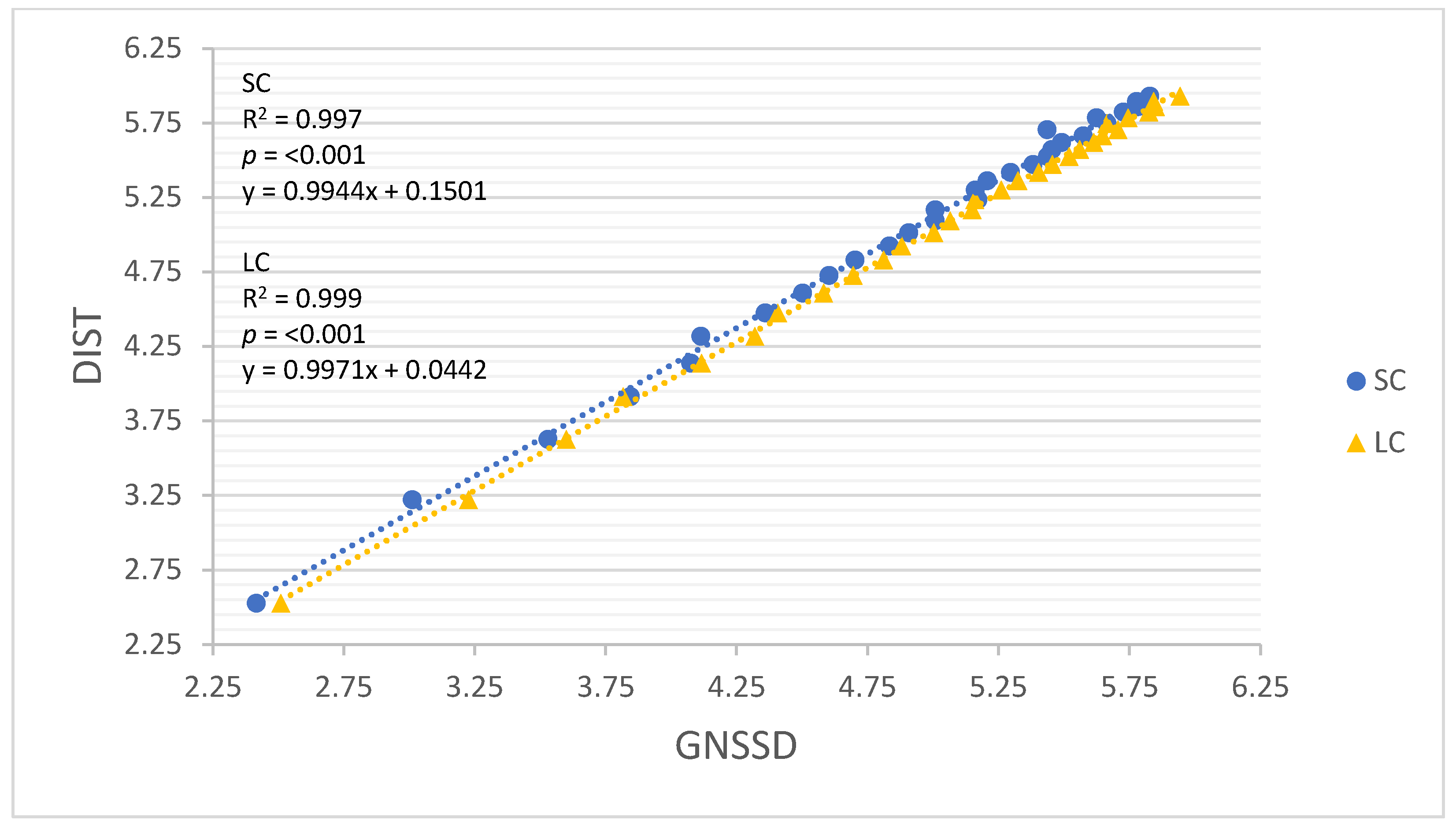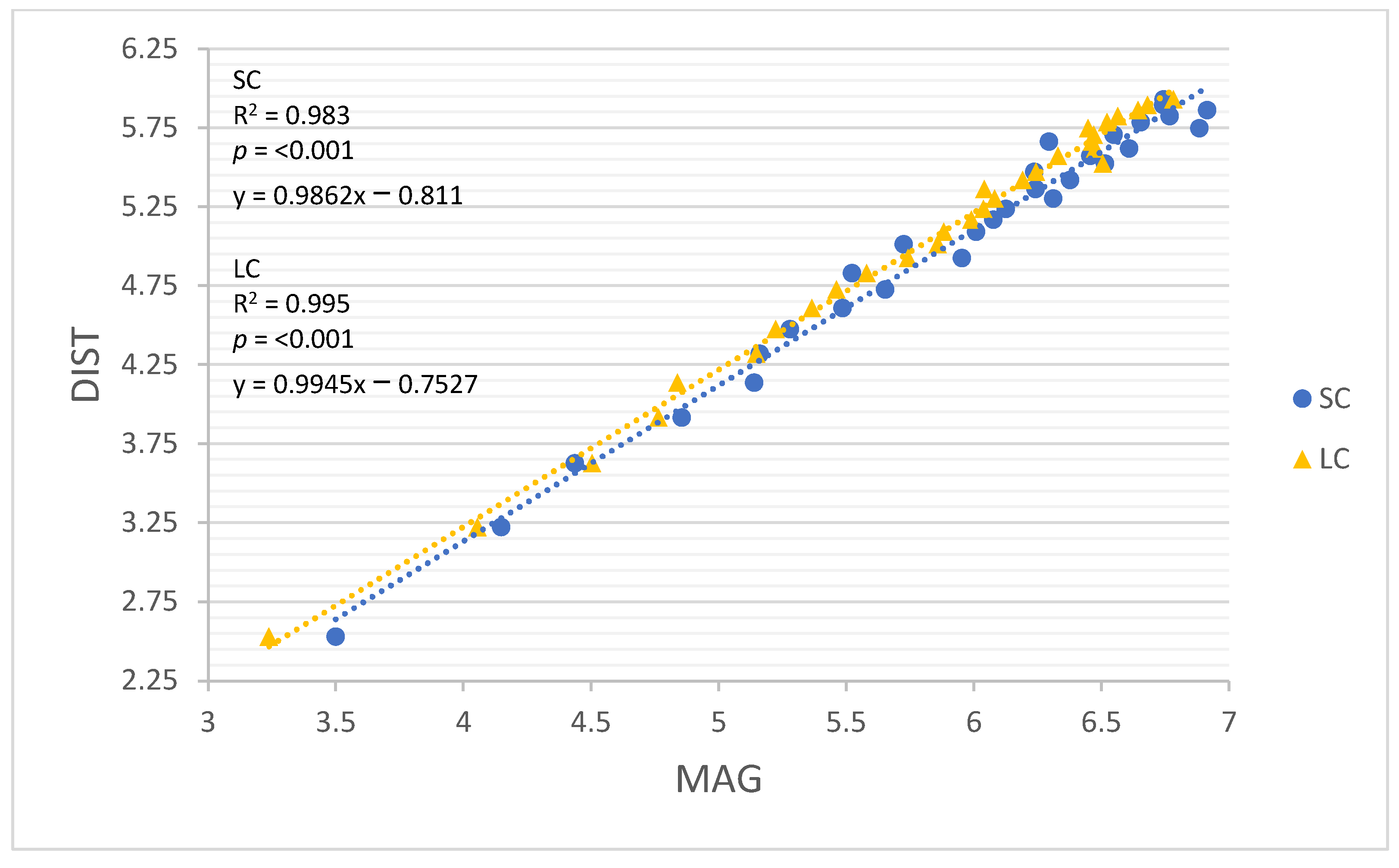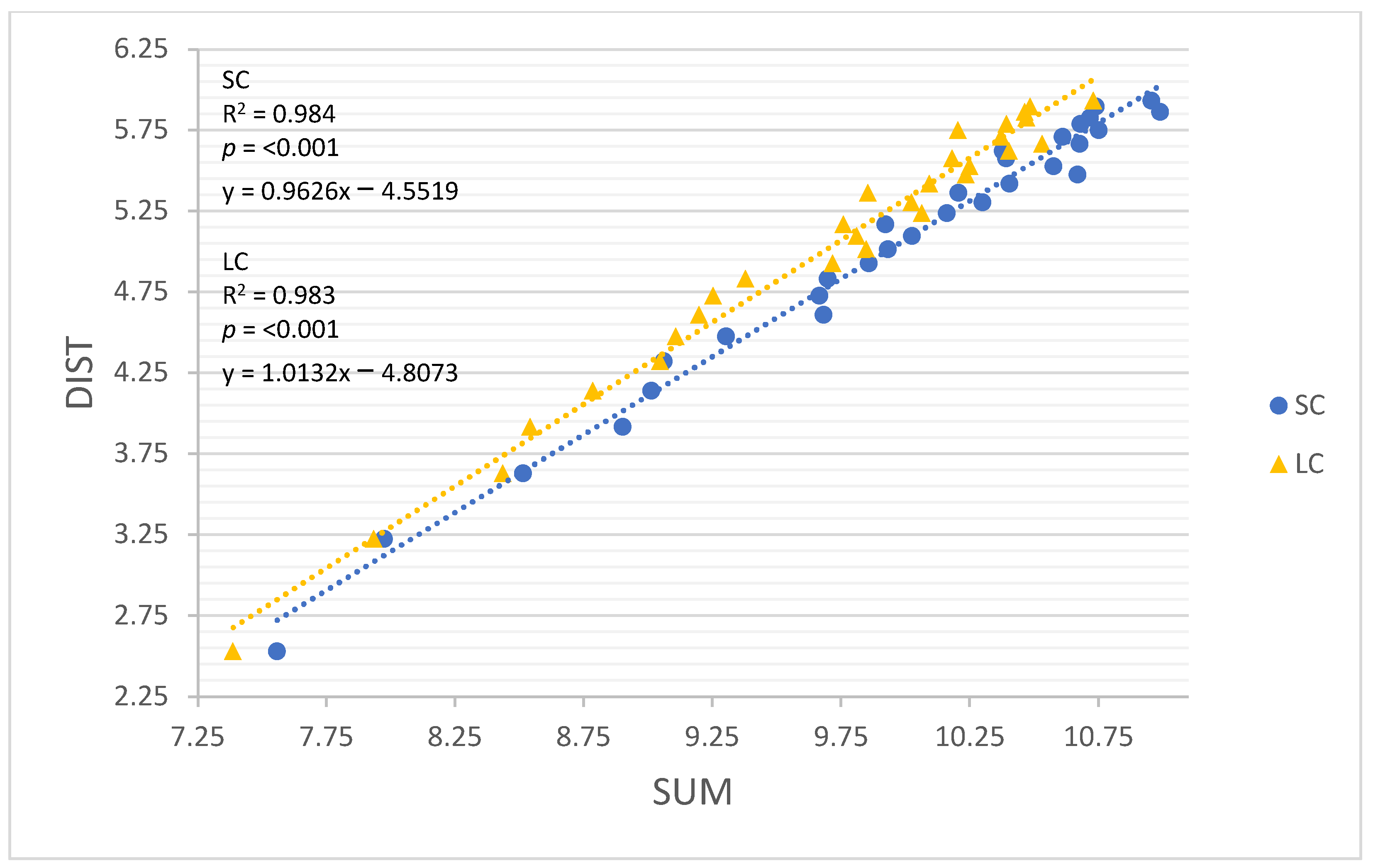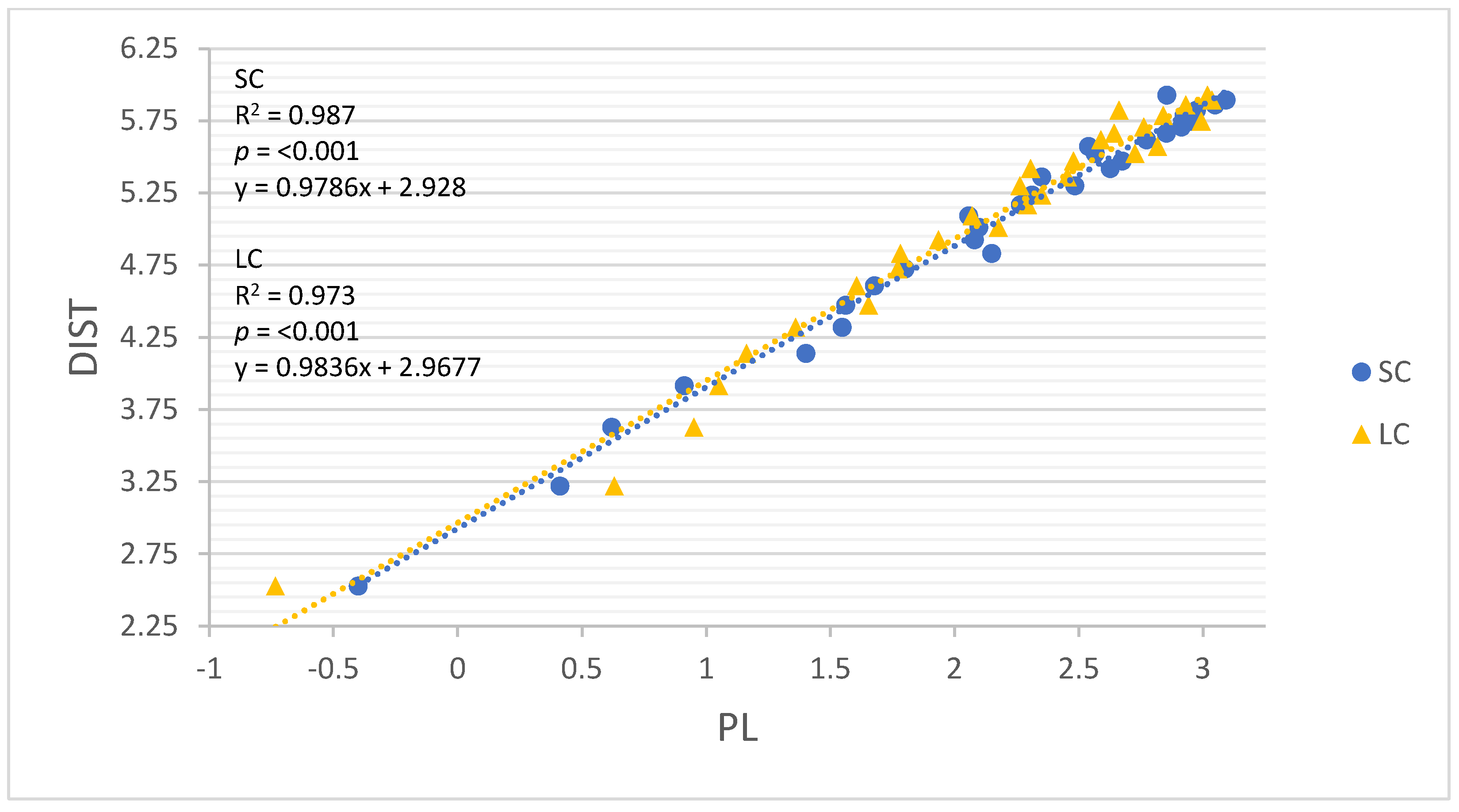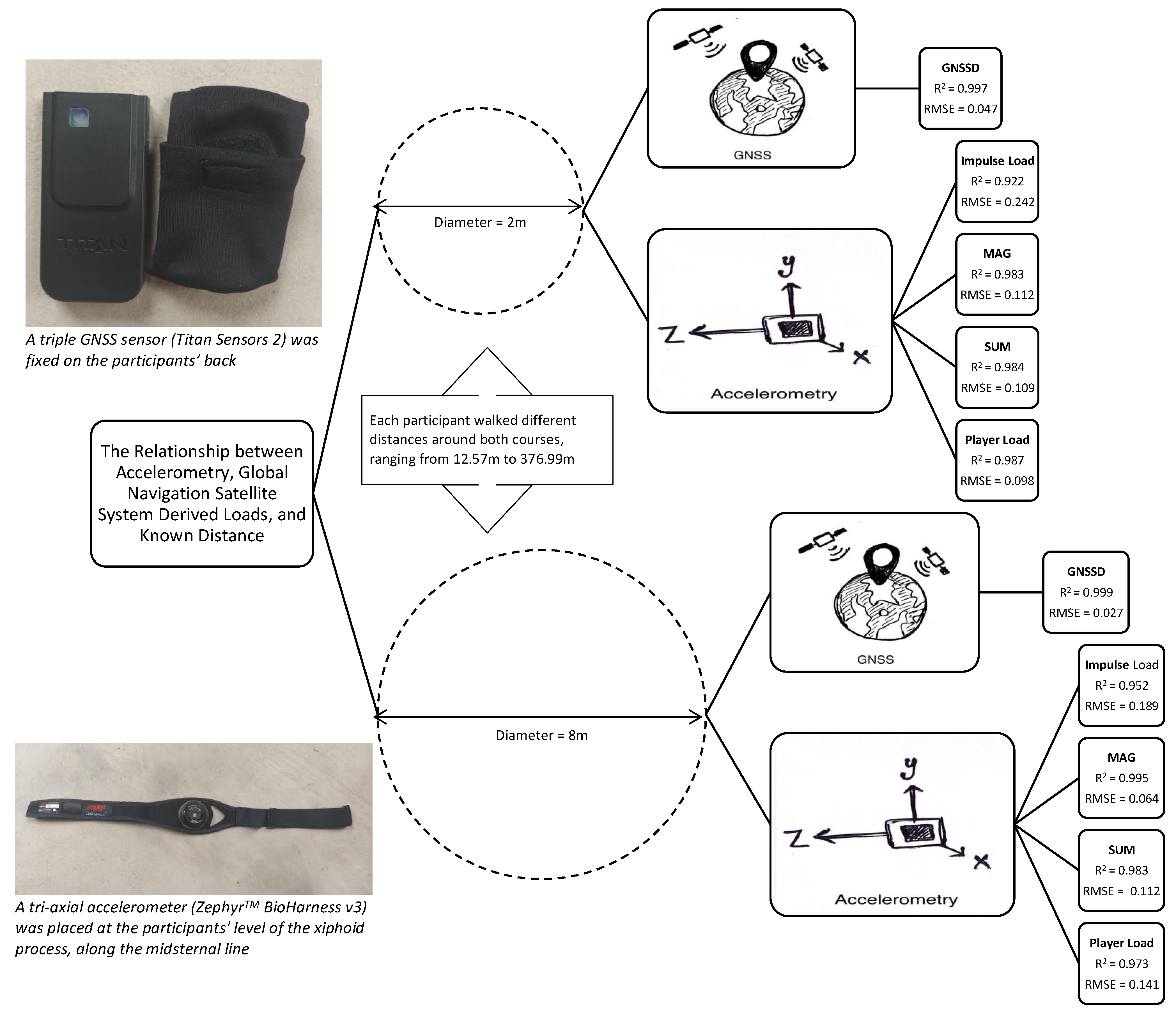1. Introduction
Wearable technologies have become popular tools used in team and individual sports. Tracking player activity using these microtechnologies is an essential component of load monitoring [
1]. Accelerometers and Global Navigation Satellite System (GNSS) devices have become some of the dominant wearable technologies used to monitor training-load in sport [
2]. These technologies can be integrated or used separately to provide an indicator of the external work performed by athletes; consequently, practitioners may be better able to manage fatigue and direct adaptation. GNSS primarily measures horizontal displacement, while accelerometers primarily measure acceleration in single or multiple axes. The role of accelerometers and GNSS in load monitoring has received increased attention across a number of sports in recent years [
3,
4]. Despite this, the relationship between both technologies to quantify the same load is not well established.
Accelerometers are responsive motion sensors that measure the magnitude of acceleration in one or more axes. Accelerometers are valid and reliable instruments to measure training load in the field and in laboratory environments [
5,
6,
7]. There is a growing body of literature that recognizes the ability of accelerometers to quantify the external demand of team and individual sports. For instance, the within and between device reliability of accelerometers has been established across a variety of movement demands in both laboratory and on-field conditions in Australian football [
8]. Gentles et al. [
9] found strong to nearly perfect correlations between accelerometry derived training load and session rating of perceived exertion (sRPE) (r = 0.84;
p < 0.001) and total distance measured using GPS (r = 0.95;
p < 0.001) among NCAA women’s soccer players [
9]. Accelerometers have also been used to illustrate the differences in the activity profile between single and double match play in tennis [
10]. In rugby, accelerometers outperformed GPS in quantifying positional (backs vs. forward) and halves (1st vs. 2nd) differences in player maximum mean movement [
11]. Moreover, accelerometry has also been shown to be a valid assessment of a test designed to simulate basketball play, suggesting that accelerometers can be used to quantify the external demand of basketball [
12].
Many accelerometry derived metrics have been used in the literature to quantify training load, including Body Load [
13], Player Load [
8], Force Load [
14], Dynamic Stress Load [
15], and Impulse Load [
9]. Although Player Load is the most commonly reported measure in the literature [
16], its potential to monitor training load has been questioned [
17]. Player Load is the sum of the square root of the sum of absolute differences of acceleration divided by the device sampling frequency [
17]. Therefore, Player Load does not represent the sum of all accelerations, and of the available accelerometry derived measures, it may not best represent training load [
17]. Additionally, training-load could be misrepresented due to the inclusion of non-locomotor activities in Player Load [
14]. Interestingly, different equations and descriptions for Player Load have also been reported in the literature [
8,
11,
18]. Player Load has also been described as Body Load [
13] and Acceleration Load [
19]. To our knowledge, no study has compared different accelerometry derived measures when assessing training load, indicating a need for further investigation of accelerometry based measures of training load.
GNSS is an umbrella term that includes several different satellite networks including Global Positioning System (GPS), Global Navigation Satellite System (GLONASS), Galileo, and BeiDou. In sport, GNSS networks are used to provide information about a player’s position, velocity, and movement patterns on the field. Total distance and distance in speed zones are common variables used to monitor training loads. GNSS networks such as GPS have been shown to be valid indicators of distances of 40 m completed during different movement patterns but may not be a valid measure of shorter distances (less than 20 m) completed during high speed running, sprinting, and change of direction [
20]. Higher sampling frequencies (5–10 Hz) have been shown to improve the accuracy of GPS [
20,
21], although some evidence suggests that increasing sampling frequency to 15 Hz does not improve accuracy when assessing distance completed during unstructured movements [
22]. Assessing player position using GNSS networks may be influenced dramatically by the number and separation of satellites that are connected to the receiver. GNSS enables receivers to acquire signals from multiple satellite networks (e.g., GPS, GLONASS, Galileo, and BeiDou), increasing the number of available satellites. Combined satellite systems improve satellite geometry and resulting precision [
23]. Dilution of Precision (DOP) is a description of satellite geometry. DOP is composed of two elements: horizontal dilution of precision (HDOP) and vertical dilution of precision (VDOP) (for more detail about DOP, see [
23]). HDOP is one indicator of GNSS accuracy and is influenced by the separation of the satellites. HDOP values range from 0 to 50, with a value of less than 1 considered the ideal distribution of satellites. HDOP is low and precision is excellent when substantial distance exists between satellites, while HDOP is high and precision is poor when satellites are in close proximity. Additionally, indoor fields, stadiums with high walls or roofs, and cloudy weather are factors that can reduce the quality of GNSS data [
4].
Recently, receivers capable of acquiring signals from multiple GNSS networks simultaneously (e.g., GPS, GLONASS, Galileo, and BeiDou) have enhanced the availability and signal strength of surrounding satellites [
24]. Beato et al. [
25] suggested that using multiple GNSS networks could explain the smaller bias (2.3 ± 1.1%) when measuring total distance during a sport-specific movement protocol [
25] compared to the author’s previous research that used only GPS to detect total distance in a shuttle run over 5–20 m (2.53 ± 6.03%) [
26]. Future research should compare the quality of data from single and multiple satellite systems in sport.
To date, several investigations have assessed the relationship between accelerometry and GNSS derived measures. A study by Polglaze et al. [
27] found large to very large correlations between Player Load and total distance accumulated during men’s hockey practice (r = 0.742;
p < 0.00001) and competition (r = 0.868;
p < 0.00001) [
27]. Additionally, a strong correlation was found between Player Load and total distance completed in men’s soccer training (r = 0.70;
p < 0.01) [
28], and a nearly perfect correlation (r = 0.95;
p < 0.001) was found between Impulse Load and total distance in women’s soccer matches [
9]. However, to our knowledge, no study has investigated the relationship between different accelerometry based metrics and GNSS with a known distance. Therefore, this study aimed to assess and compare the ability of four different accelerometry derived metrics and a triple GNSS to predict known distance completed under different movement constraints.
4. Discussion
The purpose of this study was to assess and compare the ability of four different accelerometry derived metrics (IL, MAG, SUM, PL) and GNSS to predict a known distance completed using two movement constraints. A primary finding is that both GNSS and accelerometry derived measures are valid indicators of total distance when walking is performed around a small circle and a large circle. This may also suggest that both GNSS and accelerometry are similarly capable of quantifying the distance associated with sport-related training and competition under the current experimental conditions. The results of the study are demonstrated and summarized in
Figure 7.
While all accelerometer derived measures performed well, MAG (small circle, R = 0.992, R
2 = 0.983, RMSE = 0.112,
p < 0.001; large circle, R = 0.997, R
2 = 0.995, RMSE = 0.064,
p < 0.001) and SUM (small circle, R = 0.992, R
2 = 0.984, RMSE = 0.109,
p < 0.001; large circle, R = 0.992, R
2 = 0.983, RMSE = 0.112,
p < 0.001) performed best among all accelerometry models. MAG and SUM include locomotor and non-locomotor activities. This outcome is contrary to Buchheit and Simpson [
14], who proposed that using accelerometer-derived measures that exclude non-locomotor activities may be more useful [
14]. However, this discrepancy could be attributed to the fact that little to no non-locomotor activity was included in this study, where sport includes a substantial quantity of both locomotive and non-locomotive activity. Our findings agree with previous suggestions that different accelerometry based metrics will not equally quantify training loads in sport-related events [
17]. Further research is needed to determine which accelerometry derived metrics best quantify training load in sport. It is certainly possible that the simultaneous use of multiple accelerometry based load assessments is advantageous.
Unlike GNSS, accelerometers can be influenced by between-subjects’ variability in loading patterns (e.g., stride characteristics) [
30]. However, in this study and others [
9,
27,
28], strong relationships have been found between accelerometry derived loads and total distance, despite different participants completing various distances. Much of the criticism that PL has attracted relates to calculating workloads by summing the rate of change in accelerations instead of the absolute value of accelerations [
17]. However, in this study, although PL did not perform best among the accelerometry derived measures, its potential to detect training load was encouraging (small circle, R = 0.994, R
2 = 0.987, RMSE = 0.098,
p < 0.001; large circle, R = 0.987, R
2 = 0.973, RMSE = 0.141,
p < 0.001). Nonetheless, it may be important to address how PL would perform if repeated changes of direction were included, given that PL only increases with changes in acceleration. In accordance with the present results, a previous study demonstrated that the accelerometry derived metric average force (the product of the participant’s body mass and MAG) was a better indicator of running demands compared to PL [
12]. Future studies should investigate what, if any, advantages MAG or other accelerometry based measures may provide compared to PL.
Previous research has indicated that, independent of movement velocity (i.e., walk, jog, run, sprint), rapid directional change degrades GNSS accuracy. For instance, GNSS may underestimate distance during shuttle trials (−2.16 ± 3.84%) and overestimate distance during exercise completed on curvilinear tracks (2.99 ± 2.96%) [
31]. However, the development of multiple GNSS technology may explain the high level of accuracy found in this study, which included two different curvilinear conditions (small circle, R = 0.999, R
2 = 0.997, RMSE = 0.047,
p < 0.001; large circle, R = 0.999, R
2 = 0.999, RMSE = 0.027,
p < 0.001). Despite these promising results, questions remain about multiple GNSS system accuracy when measuring the distance completed in sport-related movements, where many changes of direction are required, and movement velocity is often higher than that used in this study.
This investigation demonstrates that multiple GNSS systems and several accelerometry derived metrics can indicate total distance completed while walking. However, a host of questions remain regarding the potential advantages associated with these technologies to quantify training loads and detect events (e.g., contact, jumps, sprinting) in sport. In this study, total distance was the only load accounted for, and only locomotor movements were included. Of course, in sport, different factors can influence training loads (e.g., acceleration, deceleration, jumping), and locomotor and non-locomotor movements will be performed. More broadly, further investigation is needed to assess the ability of GNSS and accelerometry derived metrics to measure training loads that include different movements and events such as running, sprinting, change of direction, jumping, collision, and kicking.
Although this study demonstrated that GNSS and accelerometry derived measures are valid indicators of total distance, three important limitations to this study should be considered. First, while walking was performed around circles to limit the influence of initiating movement and braking associated with changing direction and total distance was the only variable assessed, caution should be used when applying the current results to other activities. Second, participants were asked to walk at their natural pace, and no method has been used to standardize the walking speed, in which differences in the velocity rate between participants might induce some variation. Third, while the investigators were precise during course set-up and the participants followed the instructions closely, the actual distances completed by the participants were likely different than planned; albeit these differences were probably very small. Future research should investigate whether training-load quantification is enhanced using a combination of GNSS and accelerometry, or whether a single sensor, GNSS, or accelerometer is adequate to quantify training loads in sports that often include changes of direction, jumping, contact, and straight-line movement.

